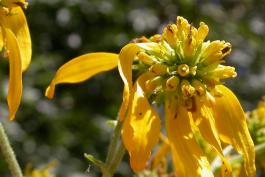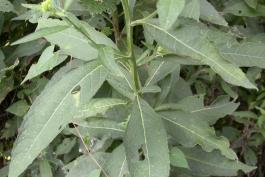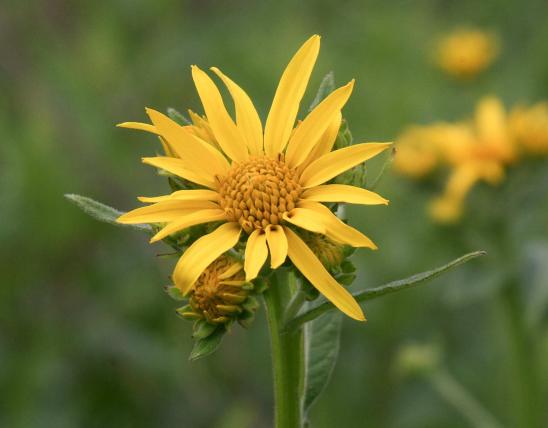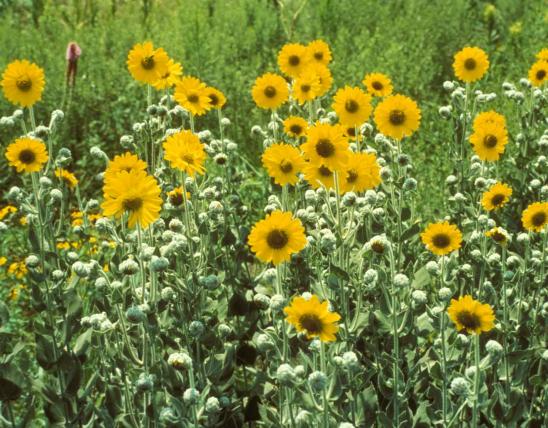
Yellow ironweed is a tall native perennial wildflower. It is a type of crownbeard, or wingstem. Its many flowerheads are borne in clusters at the top of the plant. The yellow ray flowers droop down and look like small, ragged sunflowers. The stems are winged, especially toward the bottom of the plant.
The flowerheads are numerous (8–100 per stem), borne in panicles, yellow, with 2–10 rays that droop downward and look rather ragged. The tubular disc florets are relatively long and point in all directions, with the fruiting head appearing almost spherical. Blooms August–October.
The leaves are alternate (sometimes opposite, especially toward the top of the plant), sessile, with the blade tissue extending down along the plant stem (this is one of several plants called “wingstems”), ovate to lanceolate, to 10 inches long, and slightly toothed; the upper surface is strongly roughened with pustular-based hairs; the lower surface is similar in terms of hairiness but less rough.
Similar species: Despite its common name, yellow ironweed is not an ironweed; ironweeds are in genus Vernonia, and they look very different, with purple flowers. Instead, yellow ironweed is a type of crownbeard, in genus Verbesina. There are 4 other species of Verbesina in Missouri:
- Yellow crownbeard (V. helianthoides) has yellow flowers, but it has only 1–10 flowerheads per stem; the flowerheads are showier, with the petal-like ray florets spreading outward like a sunflower’s, the disc florets mostly pointing upward, and the fruiting head appearing mostly hemispherical. Its leaves are hairy and softer. It begins blooming as early as May and does not exceed 4 feet in height. Scattered; most common in southern Missouri.
- Southern crownbeard, also called yellow crownbeard or stickweed (V. occidentalis), is quite similar to yellow ironweed (it confuses even experienced botanists), but it has opposite leaves that are broadly ovate (not lanceolate), and its flowerheads have only 2–5 ray flowers. In Missouri, it’s known from only one location, in Miller County. May eventually be found in southeastern Missouri. (This is an interesting story; see Human Connections below.)
- Golden crownbeard (V. encelioides) has yellow flowers, but it is uncommon and has well-defined, rather long leaf stems (petioles). The stems aren’t winged, and it’s an annual. Introduced, uncommon, and sporadic in crop fields, railroads, and roadsides.
- White crownbeard (V. virginica) has clusters of smaller, white flowerheads; when in bloom, it’s unlikely to be confused with its yellow-flowering relatives. Scattered south of the Missouri River.
Note that “true” ironweeds are in genus Vernonia, and Missouri’s Vernonia species usually have magenta-purple flowers (rarely white); never yellow.
Height: 15 inches to over 8 feet.
Scattered nearly statewide.
Habitat and Conservation
Occurs on banks of streams and rivers, bases of bluffs, sloughs, bottomland forests, and occasionally moist upland forests; also in pastures and roadsides.
This is one of the plants that often forms spectacular “frost flowers” in the fall, when a sudden overnight freeze causes the stems to burst and release quantities of sap, which freezes into intricate ribbons or flowerlike shapes that can be about 4 inches in diameter. Look for these formations early in the morning after a sudden first hard freeze. Other Missouri species that form frost flowers are the closely related white crownbeard (V. virginica) and the unrelated dittany (Cunila origanoides), which is in the mint family.
Status
Native Missouri wildflower.
Human Connections
It’s not the prettiest of our native wildflowers, but yellow ironweed and other clump-forming perennial crownbeards, with their love of moist ground, can be good choices for rain gardens, where they can absorb rainwater runoff as well as provide food for pollinators and other insects, which in turn feed birds.
One of the most popular hobbies in the world is photography. It’s satisfying to make great pictures, but with nature photography, it’s great fun simply to be outdoors hunting for beautiful subjects such as frost flowers on a bracing, clear autumn morning.
In the past, botanists have been fooled by some Missouri populations of yellow ironweed that have opposite, not alternate leaves. But yellow ironweed, despite its name, V. alternifolia, sometimes has some or even all of its leaves in opposite pairs, especially at the top of the plant (the part that is most likely to be collected). Some yellow ironweed populations in eastern Missouri have all their leaves opposite. Based on that characteristic, some botanists in the past believed that these collections represented species V. occidentalis (called southern crownbeard, yellow crownbeard, and stickweed). But the flowerheads of that species are quite different from yellow ironweed, and botanists have proven that V. alternifolia has a tricky variety in its leaf arrangement.
Therefore, southern crownbeard (V. occidentalis), once thought to be in Missouri, was excluded from Missouri’s official list of plants. It occurs in states to our southeast, including adjoining parts of Illinois, Kentucky, and Tennessee, and also in nearby Oklahoma. There’s a good chance it might eventually cross the border into our state. But in 2011, this species was discovered growing in Miller County — in central Missouri. The newly discovered population is near Tuscumbia, a historic port town on the Osage River. Starting in the 1840s, Tuscumbia was a busy place, receiving a large volume of goods from the east. Its river commerce dried up when the town was bypassed by railroads and when Bagnell Dam was completed in 1931, ending cargo shipping on the Osage. There’s an excellent chance that Missouri’s one population of southern crownbeard was established from seed attached to pioneer river cargo nearly a century ago or longer.
The name “crownbeard” refers to the two noticeable awns (pronglike points) that remain attached to the achenes (seedlike fruits) at maturity.
Ecosystem Connections
The seeds of this and other crownbeards are eaten by several types of birds and mammals.
This and other flowers that bloom late into the growing season provide nectar and pollen for many types of bees, butterflies, wasps, and other insects. Monarchs are one of several migratory butterflies that rely on late-season flowers for food.
The silvery checkerspot butterfly and the gold moth (a noctuid) use this species and its relatives as caterpillar food plants. Other insects that eat the foliage, stems, flowers, fruits, or juices of yellow ironweed include leaf-mining moths, leaf beetles, aphids, stink bugs, and gall fly larvae.
Grazing mammals such as deer and rabbits apparently find these plants distasteful.
This species and others that love moist, lowland areas form important plant communities that protect flood-prone areas from erosion. These jungle-like lowland thickets also provide habitat for a wide variety of birds, mammals, and other animals.



































